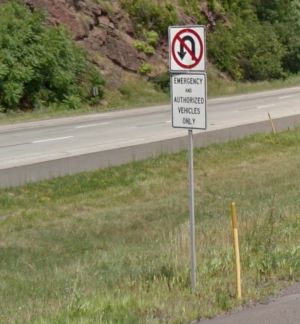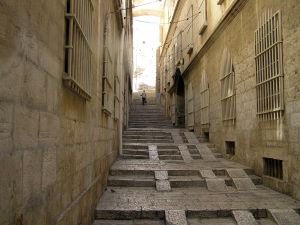Non-drivable roads 
Your car should not be here!
- As of April 2015[update] the Waze app is intended only for drivers of motor vehicles, and Waze has no plans ever to support any other application. In fact, cyclists and pedestrians who use Waze near drivable roads can damage Waze's speed and traffic database! Editors should not map any road type for the sole purpose of encouraging non-driving Wazers.
- It may be useful to map certain non-drivable roads as navigational references if they are visually obvious to drivers, for example by showing where a turn lies in relation to a railroad crossing (use the Railroad type) or a major Rails-to-Trails right-of-way (use the Pedestrian Boardwalk type).
- If the GPS Points layer clearly shows frequent improper Wazing on a non-vehicle route near drivable roads, marking this route with a non-drivable road type can prevent damage to Waze's speed and traffic database. Do not, however, use the Walking Trail type for this purpose.
- The Walking Trail road type, although listed as non-drivable, is fully routable and should only be used by experts in very limited cases.
- As of June 2015[update], the non-drivable road types of Pedestrian Boardwalk, Stairway and Runway/Taxiway should not have any type of junction with a drivable road. When crossing drivable roads, these non-drivable road types should be bridged across without a junction and set at a different elevation. Note: this guidance is subject to change.
- It is OK to junction drivable roads with the Railroad type. See specific details in the Railroad section later on this page.
- Walking Trails, and other non-drivable road type which are visible in the app, can cause significant routing issues. If a walking trail (even when not connected to any other drivable segment) is closest to the latitude and longitude of the search result, the routing server will route you to the spot on the segment closest to that walking trail.
In the sketch below, if you assume the Place target is a latitude and longitude returned by a Google search result, you would think that the actual destination would be the parking lot segment because it is the closest reachable/connected segment to the target. But it won't be. The actual destination will be where the green spot is, because the closest segment to the latitude and longitude is the walking trail, and the closest Waze can route to the walking trail is to where the green spot is.

Emergency Vehicle and DOT Service Roads 

"Emergency and Authorized Vehicles Only" and DOT Service Roads are to be treated as Non-drivable roads. These are found primarily through the median of divided highways to connect opposite direction lanes. If mapped, they should not be connected to any drivable road, with properties set to road type Private Road, and lock the segment at as high a rank as possible, up to rank 5.
Walking Trails 
| This section is new as of May 24, 2015[update]. For details, please see the forum discussion. |
Use Walking Trails only with assistance from an expert in Walking Trails. They should only be used in rare cases. Walking Trails may have strange side effects on nearby routing. Never use the Walking Trail road type for ordinary hiking paths or bike paths. Most hiking and bicycling paths should not be on the map at all.
The WME lists the Walking Trail road type as non-drivable. However, as of May 2015[update], Walking Trails are fully routable and even support Waze House Numbers. Waze treats them in some ways like "Dirt road / 4X4 Trail" but displays them differently. Historically, editors have disconnected Walking Trails to make sure Waze doesn't route drivers over them. This doesn't always work as desired. If a disconnected Walking Trail comes closer to a destination than any other road, Waze may route drivers to a location nearer to the Walking Trail than to the destination. This problem can be severe for Walking Trails passing close to many destinations in a dense neighborhood. Connected or not, the Walking Trail type should never be used where effects on local routing are not desired.
The name "Walking Trail" suggests that Waze wants to support pedestrians and cyclists. However, as of April 2015[update], Waze focuses on drivers of motor vehicles and has no plans to encourage or support any other application. In fact, pedestrians and cyclists using the Waze app may damage Waze. By Wazing at speeds different from nearby traffic, they can create false traffic indications and even influence Waze's records of average road and turn speeds.
Because of this effect, editors should not map Walking Trails, or any other road type, for the sole purpose of encouraging non-driving Wazers. See the descriptions of other non-drivable road types for recommended applications of those types.
If the GPS Points layer shows clearly that pedestrians and cyclists already use Waze on a path or trail that lies parallel to a drivable road, then, as of May 2015[update], the path may be mapped with a Pedestrian Boardwalk. Doing so will limit the damage these Wazers would otherwise cause to the road's speed data. Such paths should only be mapped once it is clear Wazers regularly use them.
Applications 
In rare cases, connected Walking Trails can bring drivers to destinations where otherwise Waze might fail to offer the best route. For example:
- A concert pavilion in an urban park accessed by a pedestrian path from a distant parking lot.
- A train station reachable from either side of the tracks but with no drivable road across them.
- A destination addressed on a non-drivable footpath.
A connected Walking Trail may be used to route drivers to such destinations. If the Walking Trail goes through from one drivable road to another, ensure that outgoing turn restrictions are red to disallow through routing via the Walking Trail. Lock the Walking Trail as this is uncommon usage that may puzzle other editors.
Orientation or destination applications involving foot or bicycle paths that do not require routing, such as marking where an obvious bicycle path crosses a road or where a trailhead is located, should not use the Walking Trail type. Use Pedestrian Boardwalks, Stairways, or Point Places as appropriate.
Naming 
If destinations are addressed using House Numbers on a Walking Trail, it is essential that the Walking Trail's name and city fields be set accordingly so that routing to the addresses will work. For other routing situations, Walking Trails should be named to alert drivers that they must leave their car. For example, a Walking Trail connecting the two sides of a train station may be named "Station Access Footpath".
Pedestrian Boardwalks 
| | | | | | | | | |

Stairway 
| | | | | | | | | |
